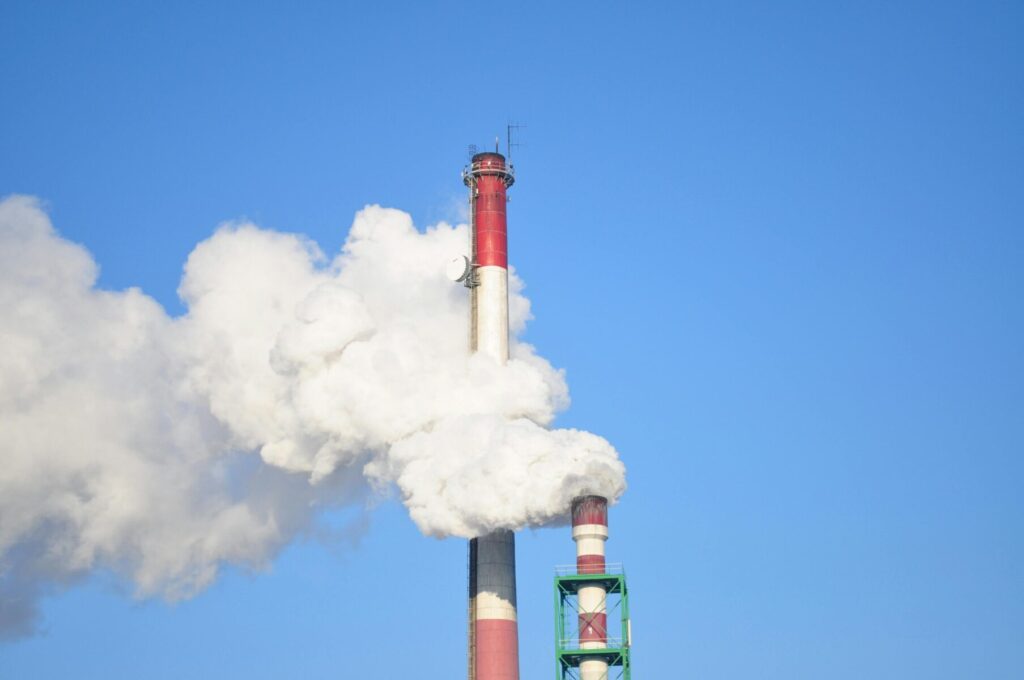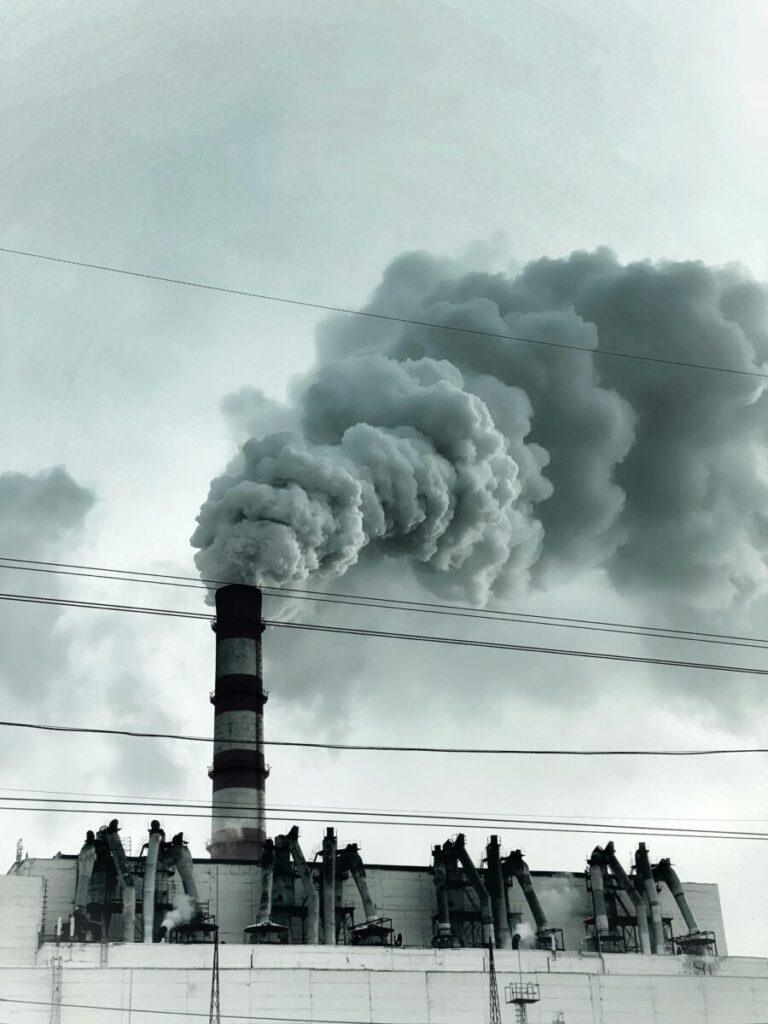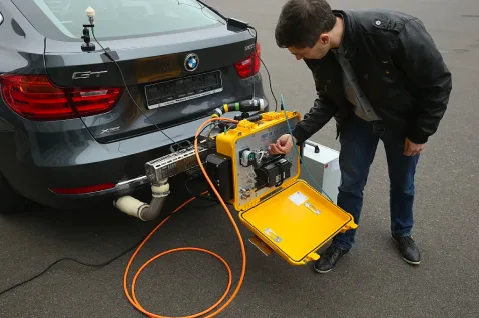
7.28 billion people, or 88% of the world’s population: that’s the number of people directly exposed to unsafe average annual concentrations of industrial air pollution, PM2.5 in particular, according to a 2022 World Bank Group publication.
If you’re an original equipment manufacturer or industrial business, you do the world an enormous amount of good by leveraging best practices at reducing industrial air pollution. What’s more, your customers (and our planet) will love you all the more for it.
With that being said, how exactly does industrial air pollution affect air quality? And, how can you measure and verify the amount of air pollution emitted through vehicle emissions, one of the world’s largest and most common sources of air pollution?
Join us as we look at how industrial air pollution affects air quality and how to protect yourself, your business, and our planet from primary and secondary pollution.
In this article, we’ll discuss:
- Common causes of industrial air pollution
- Types of industrial air pollution
- Common sources of industrial air pollution
- Measuring industrial air pollution emitted from common sources, like vehicle emissions
- How to protect yourself and your operation from industrial air pollution
Common causes of industrial air pollution

We know that industrial air pollution tends to derive from a few common sources.
With that being said, familiarizing yourself with the common causes of industrial air pollution is the first step in mitigating the environmental and social impacts they have on public health.
Common causes of industrial air pollution include:
- Ineffective legislation and regulations to control emissions and waste
- Poor enforcement of existing environmental standards
- Reliance on older technologies that produce waste and air pollution emissions
- Unsustainable business practices and operational procedures, including:
– Increased production, which can lead to higher emissions and waste
– Improper and extensive resource extraction
– Cost-cutting measures that can lead to environmental negligence
– Moving industrial activities to countries with more lax regulations
– Over-reliance on hydrocarbon-emitting vehicles for transportation, logistics, and manufacturing
Table: Common gases that cause industrial air pollution
| 1. Carbon dioxide (CO₂) 2. Carbon monoxide (CO) 3. Sulfur dioxide (SO₂) 4. Methane (CH₄) 5. Nitrogen oxides (NOx) 6. Volatile organic compounds (VOCs) 7. Hazardous air pollutants (HAPs) 8. Particulate matter (PM) 9. Mercury (Hg) 10. Lead (Pb) 11. Hydrogen Chloride (HCl) 12. Ozone (O₃) 13. Benzene (C₆H₆) |
Types of industrial air pollution

Common types of industrial air pollution include the following:
- Greenhouse gases like carbon dioxide and methane
- Sulfur dioxide emissions
- Nitrogen oxides, a key contributor to acid rain
- Volatile organic compounds (VOCs)
- Hazardous air pollutants (HAPs)
Despite contributing a large share of air pollution, these pollutants can be controlled and even reduced. Using high-quality products, such as the Ionic Particle Gauge (IPG) or a continuous emissions monitoring system (CEMS), airborne pollutants can be measured, verified, and reported more accurately, allowing scientists and manufacturers to create greener, cleaner products and systems that emit fewer pollutants and emissions.
But before we can quantify, measure, and support a cleaner industrial operation, we need to know where we can use IPG and CEMS.
We need to understand the sources of common industrial air pollution.
6 Common sources of industrial air pollution

The six most common sources of industrial air pollution today come from the following:
- Fossil fuel-fired power plants
- Petrochemical refineries and chemical manufacturing
- Metal production and processing
- Industrial boilers and furnaces
- Cement and mineral processing
- Commercial transportation (and vehicle use)
For this article, we’ll discuss refineries, steel mills and plants, petrochemical and natural gas plants, mining sites, and industrial air pollution via commercial transportation — some of the largest contributors to industrial air pollution today.
Refineries
What exactly do we mean when we say “refineries?” Refineries are industrial facilities that transform raw materials into key products.
Crude oil, natural gas, metals, sugar, and salt are just a few natural resources that are often processed in a refinery. With such diverse natural resources processed in refineries, you can imagine that refineries also emit a variety of airborne pollutants that affect air quality and human health.
PM2.5 is often emitted. PM 2.5 can cause respiratory and cardiovascular problems, which is why keeping tabs on PM2.5 emissions is crucial.
Other common industrial air pollutants emitted by refineries include:
- Sulfur dioxide and nitrogen oxides, both of which contribute to smog, acid rain, and respiratory health issues
- VOCs, which plays a role in ground-level ozone formation
- Carbon monoxide, which can impair oxygen’s natural flow through the body
- Benzene, a substance that’s known to cause cancer
- Hazardous air pollutants like formaldehyde, which pose risks to certain areas of the body (such as the gastrointestinal tract, pharynx, esophagus, and stomach)
Steel mills and plants
Similar to refineries, steel mills and plants play a role in producing products from raw materials. Steel plants emit hazardous pollutants into the atmosphere from the processing of airborne pollutants such as PM2.5, sulfur dioxide, nitrogen oxides, carbon monoxide, volatile organic compounds, and heavy metals.
In fact, the heavy metals lead, cadmium, and mercury are toxic and can cause neurological problems. Keeping tabs on the harmful and serious health effects emitted from iron and steel factories is key to reducing air pollution.
Petrochemical and natural gas plants
A petrochemical and natural gas plant often processes hydrocarbons. These hydrocarbons come from oil and natural gas, which can then be used to build products.
For example, medical plastics and resins, food preservatives, and select fertilizers are made with petrochemicals. As you can imagine, petrochemicals emit some of the same hazardous airborne pollutants as steel mills, all of which can affect air quality and health.
In particular, petrochemical and natural gas plants emit acetaldehyde, toluene, xylene, and other chemicals, which can pose health risks.
Mining sites
Mining sites around the world release pollutants into the air that can impact overall well-being and the quality of our health and air. PM2.5 and silica dust is often kicked up into the air, as well as gases like methane, carbon monoxide, sulfur dioxide, and other nitrogen oxides.
Particularly hazardous to the environment and our health are lead (Pb), mercury (Hg), and other compounds found in explosives. What’s more, air pollutants emitted from mining sites can pose serious health problems for our lungs, such as black lung disease.
Industrial air pollution in commercial transportation
Though commercial transportation doesn’t cause industrial air pollution outright, the fuel that’s emitted via vehicle emissions pollutes our air.
PM 2.5, sulfur dioxide, and nitrogen oxides are key players in the fight against air pollution produced by heavy-duty, off-highway commercial vehicles and locomotives.
What’s more, greenhouse gases such as carbon dioxide and methane are huge contributors to air pollution. They’re some of the largest greenhouse gas contributors to climate change.
Measuring and verifying industrial air pollution for vehicle emissions is key

While we can’t eliminate air pollution or reverse its effects on our planet, we can drastically reduce it to ever smaller amounts — particularly in the transportation sector.
Aside from commuting to businesses and homes by using hydrogen and electric-powered vehicles or a standard bicycle, industrial organizations can take other key actions to reduce their climate footprint and make their operation more profitable, lean, and green.
One of the key ways to do so is through portable emission measurement systems (PEMS) and integrated PEMS (iPEMS).
PEMS and iPEMS provide real-time data on pollutant levels involved in chemical production, vehicle production, and other invaluable industrial processes. The PEMS and iPEMS devices allow for on-road and in-field measurements for a variety of industrial applications.
Need to quantify the volume and type of emissions emitted from the tailpipe of your commercial vehicle? No problem.
With PEMS, you can measure, verify, and monitor pollutants on the fly. For example, with the Axion™ RS PEMS device, the Axion reports data in grams per second of industrial air pollution particles emitted from an industrial device while the device moves.
The Axion then provides all data for calculating grams per mile, gallon, and kg. It does so using a proprietary (and patented) flow calculation method.
Finally, on-board engine information is captured with either vehicle/vessel OBD hardware and software or an engine sensor array.
By measuring and verifying industrial air pollution using portable emissions devices, industrial operations specialists and original equipment manufacturers (OEMs) can make more timely, accurate, and informed decisions to support a greener, cleaner operation.
Did you know?
Did you know that industrial air pollution isn’t just relegated to standalone facilities like industrial plants, mines, and refineries? They can be found on the road and at construction sites.
To reduce air pollution on the road, we need real-driving emissions (RDE) tests, which are tests that measure common industrial air pollution pollutants. These tests are conducted while a vehicle is in use and on the road, not just while it’s in a laboratory.
These emissions can be investigated everywhere, in light-duty and heavy-duty internal combustion engine vehicles.
Want to see air pollution measured in action? Check out this video that shows how air pollutants can be measured and verified from a vehicle as small as a moving ATV.
Protect yourself and your operation from industrial air pollution

The best way to protect yourself, your health, and your operation from industrial air pollution is by doing the following:
- If indoors during a bout of poor air quality, shut the doors and windows. Also, adjust your HVAC system so it recirculates air.
- Stay indoors when air quality is poor, and if you need to go outside, wear a surgical mask that blocks out PM2.5 and PM10.
- Use an air purifier to decrease fine particulate matter indoors.
Furthermore, the U.S. is one of the world’s top greenhouse gas emitters, according to a 2023 report by the Environmental Protection Agency (EPA). As such, we have a responsibility to do as much as possible to reduce the impact of industrial air pollution.
That way, future generations can enjoy our planet for years to come.
What are you doing to create a better world for future generations? We’re doing our part by creating deployable portable emissions measurement systems (PEMS).
With PEMS, we can run more than 60 different types of diagnostic testing regimes and support over 100 different vehicles and engines for overall emissions reduction and fuel calibration testing.
If you’re an OEM or industrial operations specialist looking to quantify, measure, verify, and reduce your emissions, give us a call. Or, if you’re just interested in learning more about how our PEMS can help create a greener tomorrow, don’t hesitate to contact us anytime.
We look forward to making our planet a greener place together with you.
Measure, Report, & Verify Industrial Air Pollution With Ease.
It’s All Possible with GlobalMRV